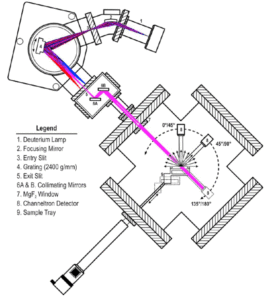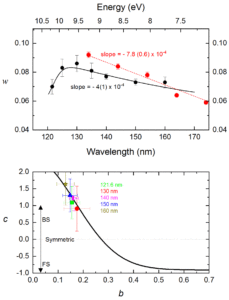Far-Ultraviolet Spectroscopy of Apollo-era Soils
Observations
Far-ultraviolet (FUV) spectra of the permanently shadowed regions (PSRs) of the Moon acquired by the Lyman Alpha Mapping Project (LAMP) instrument on board the Lunar Reconnaissance Orbiter show relative reddening (> 155 nm) that is best explained by the presence of water ice mixed in with the lunar regolith. Similarly, LAMP dayside observations reveal variations in the FUV spectral slopes also attributed to the diurnal/latitudinal variation of hydration at the lunar surface.
Key Questions:
How much water content do the LAMP FUV hydration signatures correspond to?
The abundance and the spatial distribution of the lunar water is loosely constrained, mainly due to the scarcity of laboratory far-ultraviolet (FUV) reflectance data of Apollo soils and soil-ice aggregates. For instance, the dayside abundance of hydrated species, H2O or hydroxyl, is estimated at 0-1%, while PSR water abundance are slightly higher, < 2% if present as an intimate ice-soil mixture or as high as 10% if present as frost.
A detailed understanding of the physico-chemical properties of the lunar soil and volatiles and an accurate assessment of its water abundance and distribution are critical to the in-situ utilization of these resources in future explorations.
Our Effort
We characterize the FUV photometric response of dry and water vapor-exposed lunar simulants and Apollo soils in the Southwest Ultraviolet Reflectance Chamber (SwURC). The SwURC is a high vacuum chamber coupled to a scanning grating monochromator. The rotating grating in concert with slits selects monochromatic light over a 115-200 nm bandpass. This light is incident upon the sample tray which hosts the lunar simulants or Apollo soils samples. The SwURC also houses a CsI-coated channeltron detector, which is installed on a rotating mount and traces a circular track in the principal plane measuring the power of diffuse light reflected by the simulant or Apollo soils at emission angles e spanning -70° to +75° with respect to the zenith (0° polar angle). The optomechanical layout of the SwURC is shown in Figure 1 to the left.
A key feature of the SwURC is the ability to measure absolute bidirectional reflectance made possible by (i) retractable design of the sample tray and (ii) extended dynamic range of the channeltron detector.
We have recently measured phase curves of Apollo soil 10084 and derived key parameters such as the single scattering albedo and scattering phase functions from fits of the simplified Hapke model (Figure 2).
For additional details, click here.
Future Work
We plan to extend such measurements to other Apollo soils samples, but also to further reduce the measured single scattering albedo to optical constants to enable radiative transfer modeling of LAMP albedos to accurately estimate the lunar hydration abundance. We also plan to expose cooled lunar simulants and Apollo soils to precisely known amounts of water vapor to directly establish the relation between the degree of spectral reddening to the amount of water ice present in the soil.

